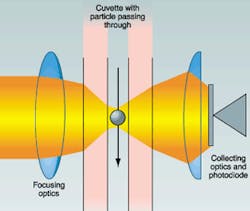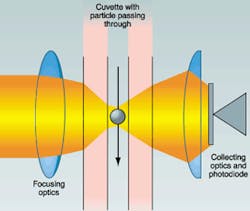Detector selection is critical for low-light-level applications
Ron J. Zimmerman
Power and energy meters are available for a broad spectrum of power and energy levels ranging from a few picowatts (or picojoules) to hundreds of kilowatts or more. High power and high energy applications typically use meters that detect power based on the heat absorbed in an element (such as a thermopile detector), while low power and energy applications generally rely on detector elements that directly convert photons into an electrical charge (a photomultiplier tube or silicon detector, for instance).
Many applications involving lasers produce suboptimum results when insufficient attention is paid to the interactions of all of the system componentsbeginning with the laser and ending with the choice of detector for the power or energy meter. System designers may not be aware of interaction issues that can occur when combining optics, lasers, and electronics, or of the opportunities for optimization that are available. This is particularly true of low-light-level applications such as those found in biotechnology, in which fluorescence signals from cellular or genomic samples are quite small when compared with background or excitation radiation.
A typical laser-based application focuses the output from a laser (pulsed or continuous wave) onto a sample through a train of optics. When the light interacts with the sample, an output occurs (fluorescence or absorption, for example) that can be measured. The output is gathered by a further train of optics and focused onto a detector. The signal from the detector is amplified and processed to yield the final result. The key is whether the overall system has sufficient sensitivity to pick out a clear signal from the noise.
Comparing low-light-level detectors
Three basic detector types are commonly used for low-light-level power and energy meters: photomultiplier tubes (PMT), silicon photodiodes (including PIN diodes), and avalanche photodiodes (APD).
Quantum efficiency (QE) measures the efficiency of the detector and is the ratio of the electrons generated by a photodetector to the incident photons, expressed as a percentage. It is related to the radiant sensitivity (S), the current generated per incident watt of optical power by the relationship
QE=[(Sx1240/λ]x100
where S is in amperes per watt and l is the wavelength of the light in nanometers. If all other characteristics are equal, the detector with the highest QE is the best choice. In general, silicon and APD detectors have a much higher QE than the PMT.
Gain refers to the internal amplification of the photogenerated signal, which is an important factor when the signal-to-noise ratio of the system is limited by the signal-processing equipment. Photomultiplier tubes and APDs are examples of high-gain devices; PIN diodes and silicon detectors are low (unity) gain devices.
Most noise sources acting on a detector have very wide frequency distributions. The wider the bandwidth of the detector and its amplifiers, the greater the noise component of the output. It is nearly always beneficial to restrict the bandwidth of the detector to the bandwidth of the signal.
The lower limit of signal detection is determined by the noise characteristics of the detector and its amplifiers. Photon-related shot noise and detector dark noise are products of the detector itself. "Excess noise" is added to the signal by the internal amplification mechanism of the detector. An important distinction between PMT detectors and APD detectors is that as gain increases, excess noise in the PMT decreases (as a percentage of overall signal) while excess noise in the APD increases. By nature of their unity gain, excess noise is not a consideration in silicon detectors.
Noise-equivalent power (NEP) is an important figure of merit for a photonic detection system. The NEP corresponds to a signal-to-noise ratio (S/R) of 1 and represents the minimum signal that the sensor can detect. It can be represented by the equation
NEP=(Itotal/S)x(W/Hz1/2)
in which Itotal is the total detector noise in A/Hz1/2. The square of the system's NEP is the sum of the squares of the NEPs for each invidual source of noise in the system:
null
where NEP2(f) equals noise as a function of frequency and H2 (f) equals frequency response of the noise transfer function.
A real-world illustration
In a real-world biotechnology application, a signal-to-noise problem was analyzed and solved by the Electro-Optics division of Melles Griot (see Fig. 1). In the application, microspheres flowing through a quartz cuvette were illuminated by a laser. When the biological sample in the microsphere fluoresced, the light was gathered into a power meter. Due to low signal levels, an APD was used as the detecting element. Unfortunately, the processing equipment was unable to pick out the signal from the surrounding noise.
The first task was to calculate the amount of power actually reaching the microsphere and the level of the resulting fluorescence. The microsphere traveled through the cuvette at a rate of 1 m/s and took approximately 140 µs to traverse the beam (see Fig. 2). Peak fluorescence occurred only near the peak of the Gaussian intensity profile, over a 10-µs window. The power generated at the detector was determined to be less than 25 pW. Further analysis indicated that the measured NEP for the detector system was 1 nW rms. Consequently, the signal was lost in the noise.
After determination of the basic problem, the bandwidth was analyzed. The 10-µs pulse train corresponds to a bandwidth of approximately 50 kHz, but the system had a detection bandwidth measured in megahertz. By adding a low-pass filter to the electronics, the NEP was dramatically reduced to approximately 30 pW rmsstill too high, but closer.
In looking at the optical design, it was determined that the bulk of the remaining noise came from background radiation. Careful optimization of the optics to reduce scatter eliminated some of the background. Furthermore, since the total signal level from the APD was much higher than the noise introduced by the downstream amplifiers, the gain on the APD was reduced, thereby reducing the excess-noise component in the S/R of the detector. The sum of these adjustments reduced the NEP to less than 10 pW rms, well within the requirements of the system.
In this particular case study, success was realized by the ability to optimize the optical design of a system around both the detection optics and the electronics supporting them.
RON J. ZIMMERMAN is the sales and marketing manager at Melles Griot, 4601 Nautilus Court South, Boulder, CO 80301-5303; e-mail: [email protected].



